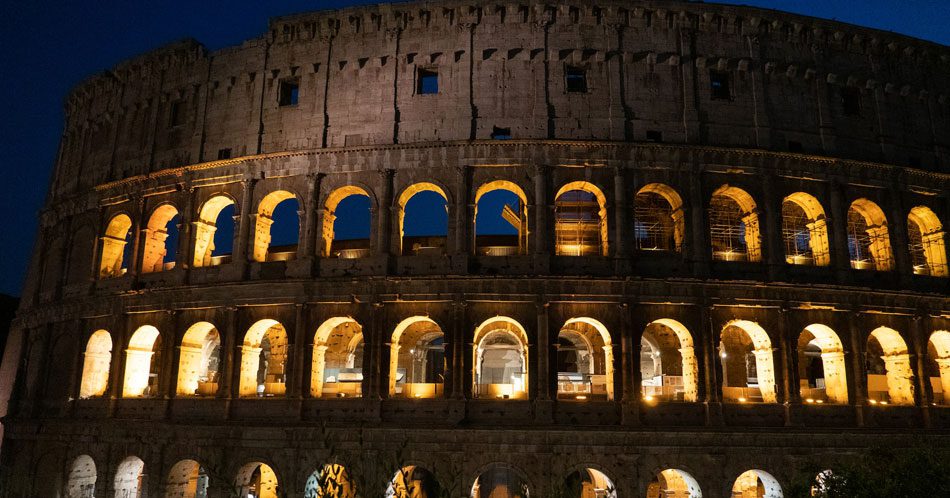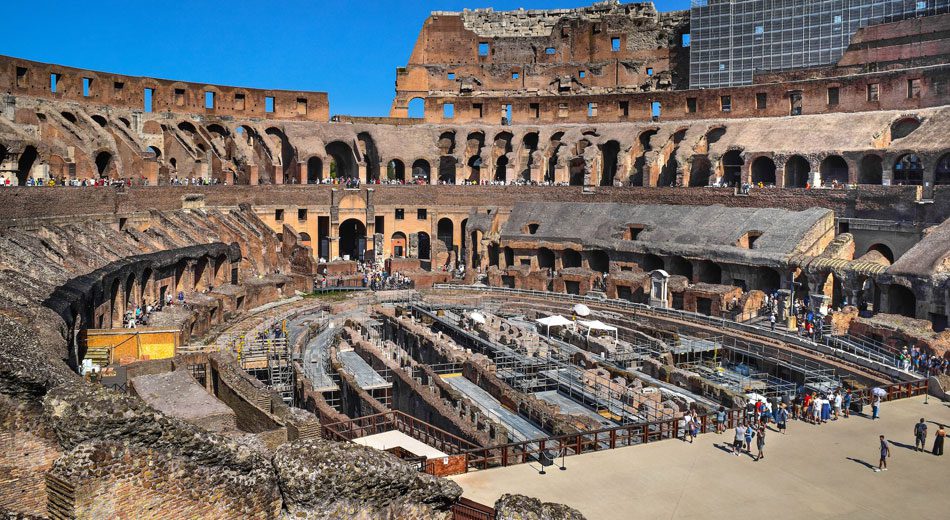The Colosseum in Rome features one of the most impressive feats of architecture in the world. It was built in the 70 and 80 AD by the emperor Titus. The massive amphitheater was his gift to the Romans. It was designed to seat around 80,000 spectators, which was quite unbelievable for those times.
In this context, let us mention that King Vespasian had originally dreamt of the Colosseum and had commissioned the project which was later completed by his son, Titus. Vespasian lived a modest lifestyle and he intended to reverse the damage that his corrupt ancestors had done to destroy the ordinary Roman’s faith in the government. Hence, he decided to give the Romans an entertainment site that was to be built exactly where Vespasian’s ancestors’ Golden Palace once stood. Building the Colosseum meant demolishing the Palace.
The Colosseum was built for the purpose of hosting public spectacles and games, which were an important aspect of Roman life. The events included animal hunts, mock sea battles, gladiatorial contests, and public executions. It was a place that was associated with bloodbaths and horrific deaths but is also an engineering marvel of the times. These events not only entertained the masses but also served as a way for the ruling class to sway their hold over their subjects.
The architects of the time put extensive thought into every detail in the master plan of the Colosseum. They designed the monument with such precision and mathematical detail that the structure stood the test of time for thousands of years. 20,000 to 30,000 workers or slaves were involved in the construction process as this was an ambitious project that was to be launched on a grand scale totally unmatched for the times.
The vaults and arches of the Colosseum were made of Roman cement, concrete, marble, and stones, among other materials. The workers started the construction of the Colosseum with arches. The foundation of the structure moved in concentric circles that moved inwards toward the arena. It took the workers a decade to give fruition to the Colosseum blueprint.
The seats closest to the arena were raised to about 7 feet and were fenced off to protect the sitting crowd from the wild animals on the loose in the arena. The seats were adorned with intricate works of art. The seats in the higher levels of the amphitheater were, however, less ornate and less comfortable. Additionally, the builders used marble and iron gate dividers to segregate people by the class during seating.
5 Facts About the Colosseum

- UNESCO World Heritage Site: The Colosseum is a UNESCO World Heritage Site that is recognized for its cultural value and historical significance. Efforts are on to preserve the structure for future generations. It was also chosen as one of the new Seven Wonders of the World.
- Largest Amphitheater Ever Built: The magnificent structure is epic in itself. It remains one of the largest amphitheaters in the world, especially to think that the project was ideated and created some 2000 years back when people neither had the required sophisticated resources, knowledge, or advanced training to execute complex construction plans.
- An Engineering and Architectural Marvel: The Colosseum is a remarkable feat of ancient engineering. It measures 189 meters long, 156 meters wide, and 50 meters high, and could hold up to at least 80,000 spectators. The size and design are a testament to the advanced engineering skills and architectural knowledge of the ancient Romans. It had a sophisticated system of corridors, ramps, and underground passages to enable quick and efficient movement of people and animals.
- Iconic Symbol of Rome: The Colosseum is one of the most visited landmarks in the world. Its impressive size and design make it an enduring symbol of the power and influence of the ancient Roman Empire. It is also an important part of Rome’s cultural and historical identity. It was a site of public entertainment, religious gatherings, and other events. It is also one of the most featured places that appears in popular movies, TV shows, and photographs. It is one of the most beloved tourist attractions in the world.
- Present-day Colosseum is Nothing Like Past Glory: The Colosseum has undergone significant damage and alteration over the centuries. What we see today is nothing like what it looked like when it was first built. The Colosseum was subjected to a series of natural disasters like floods, earthquakes, and fires during the course of history. It was left in a state of disrepair and neglect for many years till efforts were made to restore it to its former glory and preserve the remaining structure. Extensive restoration work has been carried out to give visitors a sense of what it may have looked like in its heyday.
Debunking 5 Myths About the Colosseum

There are several myths and legends surrounding the Colosseum in Rome. Here are 5 of them.
- Christians Were Fed to Lions in The Colosseum: There is little evidence to support this claim. While Christians were persecuted in ancient Rome, there is no concrete historical record to suggest that executions happened inside the Colosseum.
- The Colosseum Was Built in One Day: Just as we hear that Rome was never built in a day, so wasn’t the Colosseum. Looking at the massive structure, it is not too hard to conclude that it took years of dedicated labor to execute the project. Given the ambitious size and complex design, it was no mean feat to accomplish the task. It took approximately 30,000 to 60,000 laborers (masons, craftsmen, artisans, and more) to give fruition to the master plan over a period of 10 years. It was a collaborative effort of the workers and engineers.
- The Colosseum Was Used For Human Sacrifice: The Colosseum was often a ground for violent spectacles and bloody contests, but there is no evidence to suggest that it was ever used for human sacrifice. It was primarily a venue for public entertainment.
- The Colosseum Was a Death Trap For Gladiators: The Colosseum was certainly a dangerous place for gladiators, but they were never forced to participate routinely in these bloody contests. In fact, many of these contests ended without a fatality, and some gladiators even enjoyed the patronage of wealthy Roman citizens and achieved celebrity status.
- The Colosseum Was a Symbol of Decadence and Moral Decline: Despite the brutality and excesses inside its premises, the Colosseum was not exclusively meant for these fights. It was also an important social and cultural institution as it was used for public gatherings on various occasions, religious festivals, and other civic events. It was much more than a mere symbol of moral decay.

